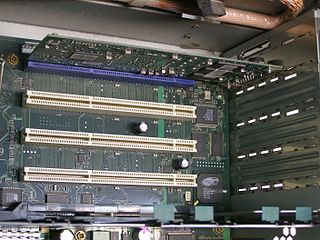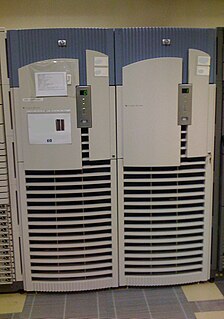HyperTransport (HT), formerly known as Lightning Data Transport (LDT), is a technology for interconnection of computer processors. It is a bidirectional serial/parallel high-bandwidth, low-latency point-to-point link that was introduced on April 2, 2001. The HyperTransport Consortium is in charge of promoting and developing HyperTransport technology.

The Power Macintosh G3 is a series of personal computers designed, manufactured, and sold by Apple Computer, Inc. from November 1997 to August 1999. It represented Apple's first step towards eliminating redundancy and complexity in the product line by replacing eight Power Macintosh models with three: Desktop and Mini Tower models for professional and home use, and an All-In-One model for education. The introduction of the Desktop and Mini Tower models coincided with Apple starting to sell build-to-order Macs directly from its web site in an online store, which was unusual for the time as Dell was the only major computer manufacturer doing this. Apple's move to build-to-order sales of the Power Macintosh G3 also coincided with the acquisition of Power Computing Corporation, which had been providing telephone sales of Macintosh clones for more than two years.

PCI-X, short for Peripheral Component Interconnect eXtended, is a computer bus and expansion card standard that enhances the 32-bit PCI local bus for higher bandwidth demanded mostly by servers and workstations. It uses a modified protocol to support higher clock speeds, but is otherwise similar in electrical implementation. PCI-X 2.0 added speeds up to 533 MHz, with a reduction in electrical signal levels.

HP 9000 is a line of workstation and server computer systems produced by the Hewlett-Packard Company (HP). The native operating system for almost all HP 9000 systems is HP-UX, which is based on UNIX System V. The HP 9000 brand was introduced in 1984 to encompass several existing technical workstation models previously launched in the early 1980s.

The O2 is an entry-level Unix workstation introduced in 1996 by Silicon Graphics, Inc. (SGI) to replace their earlier Indy series. Like the Indy, the O2 used a single MIPS microprocessor and was intended to be used mainly for multimedia. Its larger counterpart is the SGI Octane. The O2 was SGI's last attempt at a low-end workstation.

Altix is a line of server computers and supercomputers produced by Silicon Graphics, based on Intel processors. It succeeded the MIPS/IRIX-based Origin 3000 servers.
The SGI Origin 350 is a mid-range server computer developed and manufactured by SGI introduced in 2003. Their discontinuation in December 2006 brought to a close almost two decades of MIPS and IRIX computing.
The Apple Network Server (ANS) was a line of PowerPC-based server computers designed, manufactured and sold by Apple Computer, Inc. from February 1996 to April 1997. It was codenamed "Shiner" and originally consisted of two models, the Network Server 500/132 and the Network Server 700/150, which got a companion model, the Network Server 700/200 with a faster CPU in November 1996.
The Sun Fire 15K was an enterprise-class server computer from Sun Microsystems based on the SPARC V9 processor architecture. It was announced on September 25, 2001 in New York City, superseding the Sun Enterprise 10000. General availability was in January 2002; the last to be shipped was in May 2005.

The IBM BladeCenter was IBM's blade server architecture, until it was replaced by Flex System. The x86 division was later sold to Lenovo in 2014.
The AMD 700 chipset series is a set of chipsets designed by ATI for AMD Phenom processors to be sold under the AMD brand. Several members were launched in the end of 2007 and the first half of 2008, others launched throughout the rest of 2008.

The Sun Microsystems Ultra 80 is a computer workstation that shipped from November 1999 to 2002.
Intel's Skulltrail is an enthusiast gaming platform that was released on February 19, 2008. It is based on the company's 5400 "Seaburg" workstation chipset. The primary difference between Skulltrail and Intel's current and past enthusiast chipsets is a dual CPU socket design that allows two processors to operate on the same motherboard. Therefore, Skulltrail can operate eight processing cores on one system. The platform supports two Core 2 Extreme QX9775 processors, which operate at 3.2 GHz.

The HP Superdome is a high-end server computer developed and produced by Hewlett Packard Enterprise. The latest version of product, "Superdome 2" was introduced in 2010. Superdome 2 scales from 2 to 32 sockets and 4 TB of memory. When introduced in 2000, the Superdome used PA-RISC processors. Since 2002, there has been another version of the machine based on Itanium 2 processors, marketed in parallel as the HP Integrity Superdome. The classic PA-RISC Superdome was subsequently rebranded to HP 9000 Superdome. The predecessor to the Superdome was the HP V-Class.

The Ultra 24 is a family of computer workstations by Sun Microsystems based on the Intel Core 2 processor.
HP X-Terminals are a line of X terminals from Hewlett Packard introduced in the early- to mid-1990s, including the 700/X and 700/RX, Envizex and Entria, and the Envizex II and Entria II. They were often sold alongside PA-RISC-based HP 9000 Unix systems. The primary use case was connecting several graphical consoles to a single server or workstation to allow multiple users access the same (expensive) processing system from terminal systems. These X-Terminals all allowed high-resolution, color-graphics access to the main server from which they downloaded their operating system and necessary program files. All models featured limited expandability, in most cases additional I/O options for peripherals and memory for more programs or local storage. HP did not use its own PA-RISC platform for these systems, the first design used an Intel CISC processor, while all later systems used RISC platforms, first Intel i960 and later the popular MIPS.
nPar partitions are electrically isolated from other nPar partitions within the same chassis. Cells make up nPar partitions. Being electrically isolated means that if a nPar partition were to fail due to hardware failure, then the other nPar partitions would continue to work. This is contrasted with vPar partitions which exist within nPar partitions in which a failure at the hardware level for a nPar would affect all vPars within that nPar.

The Dell blade server products are built around their M1000e enclosure that can hold their server blades, an embedded EqualLogic iSCSI storage area network and I/O modules including Ethernet, Fibre Channel and InfiniBand switches.
The Ultra 60 is a fairly large and heavy computer workstation in a tower enclosure from Sun Microsystems. The Ultra 60 was launched in November 1997 and shipped with Solaris 7. It was available in several specifications.











